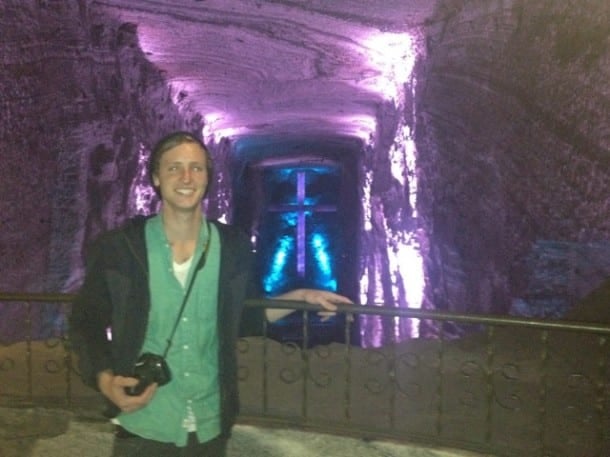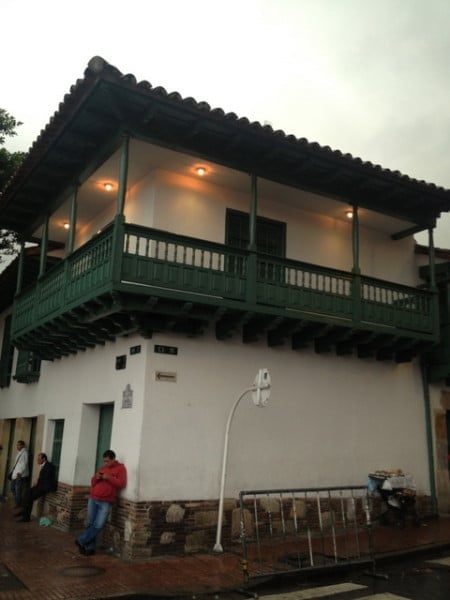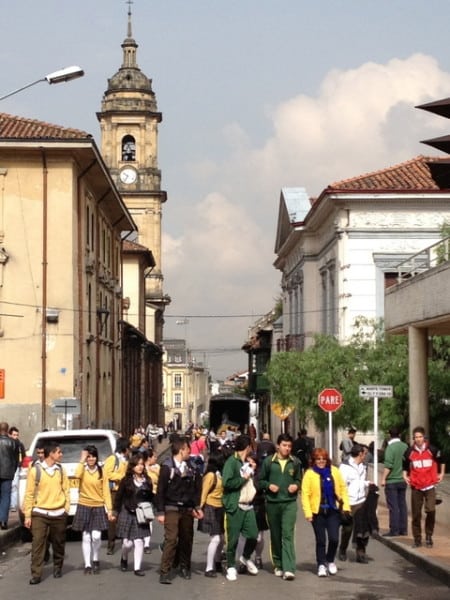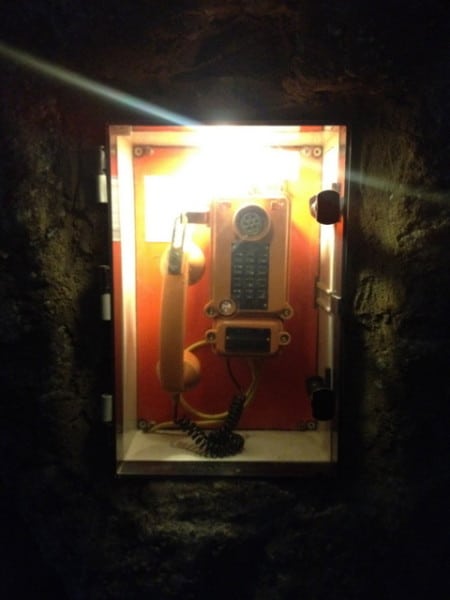
Boh-goh-TA.
The emphasis is on the last syllable in Bogotá, Colombia’s emerging capital, and that’s important. The failure to confidently push out that last “a”—to release the city’s name on a promising, upward trajectory—is a common occurrence here in the United States, whether by way of unfamiliarity, laziness (me, pre-visit), or whatever.
Again, this is important. Not because it makes you sound learned, though you are free to school your friends with it (they love when you school them). No, after visiting Bogotá myself, and as a one-time offender, I’ve decided that this mispronunciation is part of a larger misperception of the Bogotá experience.

Like the country it often stands for, Bogotá isn’t what it used to be. The city that welcomed me was a place of energy, of life, and of cultures both new and well-aged. It is the cosmopolitan and bohemian center of post-Escobar Colombia, and though you could probably argue that it still has some work to do—for example, driving can be a bit chaotic (though not Egypt or Thailand chaotic)—there’s no doubt it’s already a place the average traveler can be excited about going.
All to say I’m sure Bogota, New Jersey is very nice, but one accent mark (called a diacritic, apparently) can make a huge difference. It definitely did for me. And with a little help from a group like LivingTrips, you can add Bogotá to your own travel résumé.
A little background
Greater Bogotá sits a refreshingly crisp 2600 meters (~8500 feet) above sea level—high on an Andean plateau—just west of the country’s center. It is home to more than eight million, which makes it the fourth largest city in the Americas (after São Paulo, Mexico City and New York). Once inhabited by an estimated half-million Muisca people, it became a focal point of the Spanish-American presence after being “settled” in 1538 (as Santa Fé de Bogotá), and as a result, a nexus of Old and New World cultures. Through the many iterations of the Colombian state over the centuries, Bogotá, as the consistent seat of inconsistent power, has remained the country’s dynamic cultural center—and a swirling blend of Spanish, indigenous, African and modern, cosmopolitan influence.
Weather
Though it’s located in the tropics, Bogotá’s elevation gives it a subtropical highland climate—which means highs in the mid-60s pretty much all year. Lows, too, are consistently in the mid- to low-40s. Precipitation does vary, and the spring and fall months come with a much greater chance of rain. That leaves winter and summer as your best options; if only because I visited in the winter, I’d say it’s your best bet.
El Dorado International Airport (BOG)
Bogotá is serviced by just one airport: the two-terminal El Dorado International Airport (BOG), located just 10 miles west of the downtown area. Its El Dorado terminal (same name as the airport), through which you’ll enter and depart traveling from the U.S., is relatively clean and modern, though with some curious food choices (I got a burger with pieces of tortilla shell layered on with the sauce; wasn’t bad). Rest assured, security and obscenely priced duty-free goods are up to international expectations.
Puente Aereo terminal, which services the Colombian Avianca Airlines and therefore travelers delving deeper into the country, is a bit more chaotic. Navigation is really tough without Spanish, and the feel is a little more “not-quite-there-yet.” Of course, it’s an airport, so you’ll get there, but a guide or a little Spanish is pretty much required.
Helpful tip: In order to leave the country, you must pay an airport exit tax at the Tax Exemptions window. Show the guys in the security line your receipt, and you’ll be good to go. Except: For a stay of less than 30 days, you’re likely looking at $33 U.S., but from what I’ve heard, it’s not always so simple. Check out this really insightful guide for more information.
Getting your bearings
Keep in mind, this is a big city. And like any big city, Bogotá has been both formally and informally sliced into more navigable districts and neighborhoods. With a guide, of course, you’ll never have a problem getting around, but everybody wants to find their bearings, right? Here, the grid is unorthodox, as streets are inclined to wind diagonally and tangentially. It’s kind of illogical. But technically, it is a grid, and it works like this: Carreras (Cr., Kra. or Cra.) run north to south, while calles (Cl. or Cll.) run east to west. The forever-green mountains are always to your east, and the La Candelaria district is the center of it all—historically and grid-orically.
Oh, and don’t go south of La Candelaria. There isn’t much for visitors this way, and the word is it’s not always the safest.
Helpful tip: I’m not sure if it’s the most advanced bus system in the world, but Bogotá’s red TransMilenios do offer something most other buses don’t: the chance to haggle. If you don’t have the full 1500 pesos for a ride, you can offer the driver 1000 (one note) by holding up one finger at the stop. If the bus stops, he or she has bitten, and will pocket your money once you’re on. Just make sure to exit through the back door.
5 things to do in Bogotá

1. Salt Cathedral of Zipaquirá (on Google Maps)
Zipaquirá is not actually part of Bogotá proper. It’s close, about 30 miles out, but still, it’s outside city limits—and with the area’s unwavering traffic, my visit came with an hour-plus-long trip each way. Was it worth a half-day of Bogotá time? No question.
Named after the great king (called a Zipa) of the aforementioned Muisca people, Zipaquirá owes its great stature today mainly to its Salt Cathedral, a massive, very surreal Catholic church/complex built deep within the caverns of an active salt mine. Descending into the subterranean cathedral, which is cool even to write, takes you on a dark, winding path past smaller chapels, statues and rock formations, all of which are lifted out of the cool, damp dark by laser-tag-like neon lighting. Without its own bishop, it’s not technically a cathedral, but it’s clearly a place of religious significance, as evidenced by Sunday masses and the spattering of nuns my group crossed paths with down below. No matter your faith, though—and I can specifically vouch here—the place is spectacular.
And did I mention it’s in an active salt mine? Well, you can tour said mine as well while you’re down there. It’s a separate ticket, but it gets you a very cool, very informative window into the literal workings of a tradition that’s shaped world commerce since the time of the Muiscas. Otherwise put: I got to learn about salt production while sneaking through dark passages, banging at salt deposits with a pickaxe and wearing a light-up hat. Pretty fun stuff.
Helpful tip: If you hate crowds, or just want to double down on salt mines, the Nemocón salt mines, located just 30 minutes past Zipaquirá, are somewhat of a local secret, I’m told, and are worth checking out. The guy who manages them (and may or may not give the tours) is apparently a salt-loving character, and has in fact made unsuccessful bids for mayor in the last two elections.

2. La Candelaria (on Google Maps)
As well as its navigational center, La Candelaria is the historic district of Bogotá—and my favorite part of the city. Back in 1538, this is where the Spanish founded their Santa Fé de Bogotá, and today their legacy lives on as much in the atmosphere as it does in the 450-year-old architecture.
The Plaza de Bolívar, La Catedral Primeda and the rest are impressive, but what I enjoyed most was the warmth with which the district embraced me. To talk about the energy, and the spirit, and the authenticity of the city, I think, is to talk of La Candelaria and its kaleidoscopic Spanish Colonial buildings—red, yellow, fuscia, navy—and its swooping churches both big and small. Walking with the sunset here was a highlight of my trip, and had I had better Spanish at my disposal, I might have tried to share a chicha with the guys kicking it in the plaza.
3. Museo del Oro (Gold Museum) (on Google Maps)
Not all of La Candelaria’s history is native to the district. Inside its resident walls, Bogotá’s Gold Museum houses more than 55,000 pieces of pre-Hispanic gold and goldwork—otherwise known as the largest collection in the world. The Muisca raft, among others, is pretty impressive, but the quality of knowledge to be absorbed here, if you commit to it, is equally so. Colombia is, after all, the legendary location of El Dorado (also the name of a Muisca chief, by no coincidence), and I learned enough about that alone in an hour-and-a-half—the length of Disney’s The Road to El Dorado—to make the museum worth the stop. It’s closed on Tuesdays, though.
4. Museo Botero (Botero Museum) (on Google Maps)
Hailing from Medellín, Fernando Botero is by most accounts Colombia’s most famous and revered artist. The man behind “Boterismo” put his reciprocal love on display in the late 90s when he donated 208 works—123 of his own and 85 from his collection—to the state, and the result is Bogotá’s Botero Museum.
First of all, entrance is free, so there’s no reason not to at least pop in. But with works from Renoir, Dalí, Miro and Picasso, even those unfamiliar with Botero will find an experience worth paying for inside this repurposed La Candelaria house (though again, they won’t have to pay). I myself recognized only his “Monalisa” and a few others, and still found myself lost in more than a few of his exaggerated characters, which included many iterations of Escobar. Once again, however, it’s closed on Tuesdays.

5. Cooking class/session at La Bodega de Abasto (on Google Maps)
Right now, Usaquén is making a good case as the best neighborhood to grab a bite in Bogotá. Two separate locals used the phrase “gastronomic hub” in describing it, and a short walk through its hilly, restaurant-checked streets is enough to see why. La Bodega de Abasto, however, is more than just a great restaurant. Inspired by the organic, farm-fresh food wave, Chef Luz Beatriz Velez offers interested parties the chance to throw on chef hats and prepare their own meal—which is of course her meal that you literally help prepare. It’s a good time, full of Colombian culinary insight, and it ends with a pretty sizeable and delicious feast. Plus, its bright and colorful farmers’-market-styled interior makes it an aesthetic playground inside.
Where to eat
As noted above, bohemian Usaquén will take great care of your appetite. But with the culinary scene being what it is in Bogotá—which is to say surprisingly vast and inventive—there are literally thousands of places, in Usaquén and elsewhere, that can do the same. Here are a few thoughts to get you started:
- La Bodega de Abasto (Usaquén), where impossibly fresh ingredients become delicious, chef-inspired favorites right in front of you—with or without a cooking class
- Casa Vieja (Usaquén; San Diego; Avenida Jimenez; Zona G), whose four different locations are all good bets for traditional Colombian cuisine, including what might be the best ajiaco in town
- El Portico (Chía, Cundinamarca), which is worth the drive slightly outside the city for lunch—for which you should order the “Carne a la fragia,” the house specialty; outside, you can watch “non-violent” (no horns, no killing) bullfighting between bites, which was pretty exciting
- Gaira Café Cumbia House (Parque de la 93), a wildly popular restaurant/bar/venue owned by talented-but-less-photogenic (see his Wikipedia page) Colombian musician Carlos Vives; it serves some pretty nice seafood and meat dishes, and there’s live music if you’re into that, but it’s a little hectic
- Andrés D.C. (Zona Rosa), the most centrally located of the famed Andrés restaurant circle; the menu feels endless, the food is great and the environment is nothing short of chaotic; with live music, aggressively interactive characters and just generally unexpected shenanigans, you really have to be up for it, and even if you are, you might still wish the mimes would just let you eat in peace; still, it’s a Bogotá institution, and everyone will tell you to go there—and it really can be fun with the right group
Where to stay: Movich Chicó 97 (on Google Maps)
Movich is a big name in Colombian hospitality, and while they may not quite be up to U.S. standards across the board (the Wi-Fi in my room was pretty unreliable), the Movich Chicó 97 made for a very pleasant stay. Rooms were clean and comfortable, and the bed, ever the deal breaker, was a good one. The hotel was moderately sized (95 rooms) but felt even smaller, I think, and I have only great things to stay about the staff (two of whom went to great lengths to map me directions to the post office one morning). The in-house restaurant, too, was pretty solid overall, even peaking at delicious with the possibly seasonal pumpkin soup. Beyond that, I’ll add one more piece of what I think is good information, which is this: The “Movich Boy 97” hotel gets its seemingly strange name from its address. So you know.
































Thanks for the insight, je. My experience in Bogotá was definitely encouraging from a safety standpoint, but you’re right in saying the locals know best. Yet another reason why traveling with a group may be your best bet.
And I’ve heard the same of Monserrate—wish I’d been able to squeeze it in. Next time for sure.
There is some information that may be valuable for those who visit Bogota. There are areas of the city that are safe day and night (somewhat small), other areas that are safe just during the day, and still other areas that are unsafe at any time. Local hotels as well as the visitor services at the airport and at Plaza de Bolivar not only can give you that information but also the exact streets that divide these areas. Monserrate, a hill that overlooks Bogota is a must visit both for some good local food, but also because it has a great view overlooking the city below. There is a cable car and vermicular connecting the mountain, also trail if you want a LOT of exercise getting up. There are also free walking tours in english facilitated by staff of the visitors center that start at Plaza de Bolivar and cover much of La Candelaria.